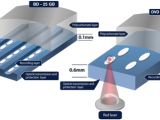It all started in 1982, when compact discs became commercially available. They were the first optical devices used to store data in a digital format, have typical capacities of up to 700 megabytes, or 80 minutes in audio format, and diameters between 60 to 120 millimeters. In 1997, a new optical storing medium became popular - the digital versatile disc or digital video disc; although indistinguishable to the naked eye from a compact disc, DVDs have typical storing capacities of 4.6 gigabytes - 8.54 for double-layer discs - and use red color lasers for read/write processes, while CDs use near infrared laser beams.
By contrast, Blu-ray discs are the latest addition to the collection of optical data storing devices. Blu-ray discs were first introduced on the market in 2006, and have capacities of 27 gigabytes for single-layer discs - 13 hours of standard video - and 50 gigabytes in the case of double-layer discs - 20 hours of standard video.
As you probably already know, digital information is stored on optical devices in pits along a spiral groove running along from the center of the disc to its edge. Laser beams read this information and convert it into an electrical signal which may be processed by a computer in order to decode and display the stored data.
More pits along the spiral groove basically translates into more store information, thus engineers are continuously working to minimizing and compacting together more pits on a given surface area. DVDs, for example, use 650-nanometer red lasers during operation, however by decreasing the wavelength of the laser beam to 405 nanometers - blue light, which also gives the disc format its name - smaller pits may be written/read on the support surface.
This decreases the track pitch of the disc from 0.74 to 0.32 microns, while the recording pits are only 0.15 microns long, twice as small as those of a DVD disc. Both the Blu-ray and DVD discs have the same thickness, but the Blu-ray discs also solve the problems related to birefringence and disc tilt, when the laser beam becomes so distorted that reading processes can no longer be carried out, by making use of a much thicker polycarbonate layer, while laser system stands closer to the disc surface thus removing the disc-tilt reading problem.
The manufacturing process of a DVD involves molding two 0.6 millimeter discs, between which a recording layer is 'sandwiched.' Blu-ray discs, on the other hand, use a single 1.1 millimeter polycarbonate disc, in order to reduce manufacturing costs. Additionally, because the laser system stands so close to the disc surface, Blu-rays are usually coated with a hard clear protective layer that keeps it safe from scratches and fingerprints.

 14 DAY TRIAL //
14 DAY TRIAL // 
